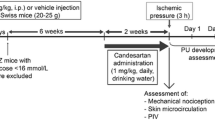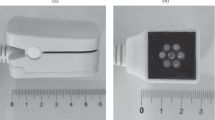Abstract
Aims/hypothesis
We investigated skin microcirculation and its association with HbA1c and the incidence of ischaemic foot ulcer in patients with type 1 diabetes formerly randomised (1982–1984) to intensified conventional treatment (ICT) or standard treatment (ST) with insulin for a mean of 7.5 years.
Methods
We re-determined the skin microcirculation of 72 patients (ICT 35 vs ST 37) from the original Stockholm Diabetes Intervention Study with iontophoresis topically applied with the following vasoactive stimuli: acetylcholine (ACh) (endothelial-dependent vasodilatation), sodium nitroprusside (SNP) (endothelial-independent vasodilatation), and capsaicin (C-nociceptive-dependent vasodilatation). HbA1c levels (mean of 14 values/patient) were prospectively collected between 1990 and 1995 and tested for association with skin microcirculation. The patients were followed until first hospitalisation for an ischaemic foot ulcer or until 2011.
Results
During the median 28 years of follow-up, three patients developed ischaemic foot ulcers in the ICT group compared with ten in the ST group (logrank, p = 0.035). At the time of iontophoresis, HbA1c was lower in the ICT group (median 57 mmol/mol [minimum–maximum 40–79 mmol/mol]) compared with the ST group (68 mmol/mol [41–96 mmol/mol], p < 0.01) (DCCT: ICT 7.4% [5.8–9.4%] vs ST 8.4% [5.9–10.9%]). Stimulated blood flow was higher in the ICT vs ST group with significantly increased perfusion units (PU) for: ACh (8.1 PU [4.6–24.7 PU] vs 5.3 PU [1.7–21.4 PU], p < 0.01); SNP (8.1 PU [2.2–20.1 PU] vs 5.6 PU [2.3–19.2 PU], p = 0.03); and capsaicin (5.0 PU [1.7–22.9 PU] vs 3.4 PU [1.5–8.4 PU], p < 0.01). HbA1c was associated with vasodilatation induced by ACh (b = −0.02, p < 0.01) and capsaicin (b = −0.02, p = 0.03). HbA1c was independently associated with ACh (b = −1.48, p < 0.01) and capsaicin-induced vasodilatation (b = −1.45, p < 0.01).
Conclusions/interpretation
Improved glycaemic control in patients with type 1 diabetes is associated with an improvement in skin microcirculation and with a lower incidence of ischaemic foot ulcers.
Trial registration: ClinicalTrials.gov NCT01957930



Similar content being viewed by others
Abbreviations
- ACh:
-
Acetylcholine
- ICT:
-
Intensified conventional treatment
- SNP:
-
Sodium nitroprusside
- SDIS:
-
Stockholm Diabetes Intervention Study
- ST:
-
Standard treatment
References
Boulton AJ, Vileikyte L, Ragnarson-Tennvall G, Apelqvist J (2005) The global burden of diabetic foot disease. Lancet 366:1719–1724
Lehto S, Ronnemaa T, Pyorala K, Laakso M (1996) Risk factors predicting lower extremity amputations in patients with NIDDM. Diabetes Care 19:607–612
Brownlee M (2001) Biochemistry and molecular cell biology of diabetic complications. Nature 414:813–820
Feihl F, Liaudet L, Waeber B, Levy BI (2006) Hypertension: a disease of the microcirculation? Hypertension 48:1012–1017
Boulton AJ (2004) The diabetic foot: from art to science. The 18th Camillo Golgi lecture. Diabetologia 47:1343–1353
Veves A, Akbari CM, Primavera J et al (1998) Endothelial dysfunction and the expression of endothelial nitric oxide synthetase in diabetic neuropathy, vascular disease, and foot ulceration. Diabetes 47:457–463
(1993) The effect of intensive treatment of diabetes on the development and progression of long-term complications in insulin-dependent diabetes mellitus. The Diabetes Control and Complications Trial Research Group. N Engl J Med 329:977-986
Reichard P, Nilsson BY, Rosenqvist U (1993) The effect of long-term intensified insulin treatment on the development of microvascular complications of diabetes mellitus. N Engl J Med 329:304–309
Nathan DM, Cleary PA, Backlund JY et al (2005) Intensive diabetes treatment and cardiovascular disease in patients with type 1 diabetes. N Engl J Med 353:2643–2653
Cefalu WT (2005) Glycemic control and cardiovascular disease—should we reassess clinical goals? N Engl J Med 353:2707–2709
Reichard P, Britz A, Cars I, Nilsson BY, Sobocinsky-Olsson B, Rosenqvist U (1988) The Stockholm Diabetes Intervention Study (SDIS): 18 months' results. Acta Med Scand 224:115–122
Gudbjornsdottir S, Cederholm J, Nilsson PM, Eliasson B, Steering Committee of the Swedish National Diabetes R (2003) The National Diabetes Register in Sweden: an implementation of the St. Vincent Declaration for Quality Improvement in Diabetes Care. Diabetes Care 26:1270–1276
Ludvigsson JF, Andersson E, Ekbom A et al (2011) External review and validation of the Swedish national inpatient register. BMC Public Health 11:450
Ragnarson Tennvall G, Apelqvist J, Eneroth M (2000) The inpatient care of patients with diabetes mellitus and foot ulcers. A validation study of the correspondence between medical records and the Swedish Inpatient Registry with the consequences for cost estimations. J Intern Med 248:397–405
Schaper NC, Andros G, Apelqvist J et al (2012) Diagnosis and treatment of peripheral arterial disease in diabetic patients with a foot ulcer. A progress report of the International Working Group on the Diabetic Foot. Diabetes Metab Res Rev 28(Suppl 1):218–224
Jensen-Urstad KJ, Reichard PG, Rosfors JS, Lindblad LE, Jensen-Urstad MT (1996) Early atherosclerosis is retarded by improved long-term blood glucose control in patients with IDDM. Diabetes 45:1253–1258
Holman RR, Paul SK, Bethel MA, Neil HA, Matthews DR (2008) Long-term follow-up after tight control of blood pressure in type 2 diabetes. N Engl J Med 359:1565–1576
Greenman RL, Panasyuk S, Wang X et al (2005) Early changes in the skin microcirculation and muscle metabolism of the diabetic foot. Lancet 366:1711–1717
Boyko EJ, Ahroni JH, Stensel V, Forsberg RC, Davignon DR, Smith DG (1999) A prospective study of risk factors for diabetic foot ulcer. The Seattle Diabetic Foot Study. Diabetes Care 22:1036–1042
Tuomilehto J, Borch-Johnsen K, Molarius A et al (1998) Incidence of cardiovascular disease in Type 1 (insulin-dependent) diabetic subjects with and without diabetic nephropathy in Finland. Diabetologia 41:784–790
Hamdy O, Abou-Elenin K, LoGerfo FW, Horton ES, Veves A (2001) Contribution of nerve-axon reflex-related vasodilation to the total skin vasodilation in diabetic patients with and without neuropathy. Diabetes Care 24:344–349
Petrofsky JS, McLellan K (2009) Galvanic skin resistance—a marker for endothelial damage in diabetes. Diabetes Technol Ther 11:461–467
Ramsay JE, Ferrell WR, Greer IA, Sattar N (2002) Factors critical to iontophoretic assessment of vascular reactivity: implications for clinical studies of endothelial dysfunction. J Cardiovasc Pharmacol 39:9–17
Millet C, Roustit M, Blaise S, Cracowski JL (2012) Aging is associated with a diminished axon reflex response to local heating on the gaiter skin area. Microvasc Res 84:356–361
Acknowledgements
We dedicate this paper to Per Reichard (Department of Clinical Science and Education, Division of Internal Medicine, Karolinska Institutet, Stockholm, Sweden), who died in 2002 and to whom we are greatly indebted. Per was a pioneer in the treatment of type 1 diabetes, guiding patients and colleagues to improve diabetes care.
In memory of Bertil Gazelius (Perimed, Järfälla, Sweden), who died in 1999, and Lars Erik Lindblad (Department of Clinical Science and Education, Section of Clinical Physiology, Karolinska Institutet, Stockholm, Sweden), who died in 2001.
We thank C. Ihrman-Sandahl (Stockholm Heart Center, Stockholm, Sweden) and M. Pihl (Department of Diabetes and Metabolism, Karolinska Institutet, Karolinska University Hospital, Stockholm, Sweden) who performed the practical investigations. We thank L. Benson (Department of Clinical Science and Education, Karolinska Institutet, Stockholm, Sweden) for statistical advice.
Funding
This research received no specific grant from any funding agency in the public, commercial or not-for-profit sectors.
Duality of interest
The authors declare that there is no duality of interest associated with this manuscript.
Contribution statement
KJ-U conducted the iontophoresis and, together with Per Reichard (PR), analysed the data and drafted an earlier manuscript that was never published due to illness of PR. Other co-writers BR and TN planned the follow-up part of this study, and analysed all the data from the iontophoresis investigation and the long-term follow-up of the present study, and drafted the manuscript. All authors took part in revising the manuscript and gave final approval of the version to be published. TN is responsible for the integrity of the work as a whole.
Author information
Authors and Affiliations
Corresponding author
Rights and permissions
About this article
Cite this article
Rathsman, B., Jensen-Urstad, K. & Nyström, T. Intensified insulin treatment is associated with improvement in skin microcirculation and ischaemic foot ulcer in patients with type 1 diabetes mellitus: a long-term follow-up study. Diabetologia 57, 1703–1710 (2014). https://doi.org/10.1007/s00125-014-3248-2
Received:
Accepted:
Published:
Issue Date:
DOI: https://doi.org/10.1007/s00125-014-3248-2




